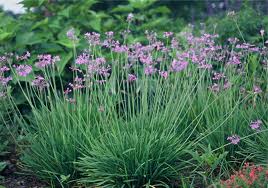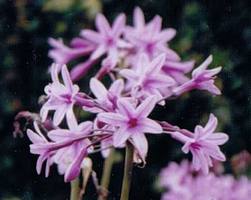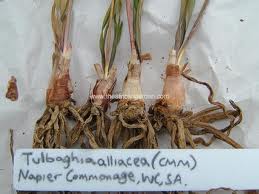Because I am asked about it all the time I decided to do an article on it: Yes, you can eat Society Garlic… well… most of it, maybe all of it.
The flowers and leaves are edible raw, no debate there. The peppery leaves can be used like garlic in salads and other dishes. The flowers are on the peppery sweet side, onion-ish. The bulbs, however, are more medicinal though there are reports of them being eaten as well. A native of South Africa it is a favored food and medicine of the Zulus. The botanical name is Tulbaghia violacea (tool-BAG-ee-uh vee-oh-LAY-see-ay or vie-oh-LAY-see-ay) Tulbaghia honors Ryk Tulbagh, 1699-1771, governor of the Cape of Good Hope. Violacea means violet-like, referring to the blossom.
One of the odd aspects of the most of the plants in the genus is that they are pollinated by moths at night when the plant manages to be lightly scented. T. violacea however is scented in the day and pollinated by bees and butterflies. (Moths are out only at night and butterflies only in the day.)
A second species, Tulbaghia alliacea, Isikhwa or Wild Garlic, is used in a similar fashion except its bulbs are cooked with meat or roasted and eaten. There are at least two cultivars, “John Rider” and “Silver Lace.” Their leaves and flowers also edible. The Silver Lace cultivar has a white stripe on each side of the leaf. Also edible is Tulbaghia ciolacea.
It’s called Society Garlic because Dutch settlers to South Africa thought it was a more polite spice to use for flavoring dishes than true garlic particularly for social events. Oh… and alliacea… (al-lee-AY-see-uh) means like onions.
Green Deane’s “Itemized” Plant Profile
IDENTIFICATION: Society Garlic is a fast-growing, bulbous plant about two feet tall. Leaves are long, narrow, strap-like, slightly fleshy and smell strongly of garlic when bruised. They grow from fat, tuberous roots which spread to form clumps of plants. The pinkish to mauve, tubular flowers, clustered into umbels of up to twenty flowers are on flower stalks above the leaves. They smell of garlic when picked. Triangular capsules replace the flowers and are grouped into a head. When ripe they split to release flattened, hard black seeds.
TIME OF YEAR: Your local summer or all year round in warm climates
ENVIRONMENT: Drought resistant, most soils, sunny or partial shade.
METHOD OF PREPERATION: Leaves and flowers raw, or cooked. Bulbs are reportedly edible but I have not tried them. Medicinally the crushed leaves have been used to treat sinus headaches, the fresh bulbs are boiled in water and the decoction taken orally to clear up colds and coughs. They have also been used for pulmonary tuberculosis and intestinal worms. The aroma also repels insects.
Herb Blurb
Posted here as published: Aspergillus flavus and Aspergillus parasiticus are important plant pathogens and causal agents of pre- and postharvest rots of corn, peanuts, and tree nuts. These fungal pathogens cause significant crop losses and produce aflatoxins, which contaminate many food products and contribute to liver cancer worldwide. Aqueous preparations of Tulbaghia violacea (wild garlic) were antifungal and at 10 mg/ml resulted in sustained growth inhibition of greater than 50% for both A. flavus and A. parasiticus. Light microscopy revealed that the plant extract inhibited conidial germination in a dose-dependent manner. When exposed to T. violacea extract concentrations of 10 mg/ml and above, A. parasiticus conidia began germinating earlier and germination was completed before that of A. flavus, indicating that A. parasiticus conidia were more resistant to the antifungal effects of T. violacea than were A. flavus conidia. At a subinhibitory extract dose of 15 mg/ml, hyphae of both fungal species exhibited increased granulation and vesicle formation, possibly due to increased reactivity between hyphal cellular components and T. violacea extract. These hyphal changes were not seen when hyphae were formed in the absence of the extract. Transmission electron microscopy revealed thickening of conidial cell walls in both fungal species when grown in the presence of the plant extract. Cell walls of A. flavus also became considerably thicker than those of A. parasiticus, indicating differential response to the extract. Aqueous preparations of T. violacea can be used as antifungal treatments for the control of A. flavus and A. parasiticus. Because the extract exhibited a more pronounced effect on A. flavus than on A. parasiticus, higher doses may be needed for control of A. parasiticus infections.




